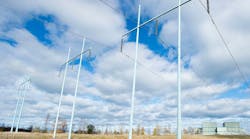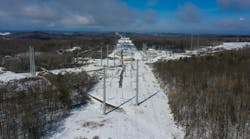The New York State Public Service Commission has approved the construction and operation of a 1000 MW transmission line stretching 330 miles from the Canadian border to Astoria, Queens, primarily through Lake Champlain and the Hudson River, with some segments on land, primarily in railroad or state highway rights-of-way.
The line would terminate at a converter station located in Consolidated Edison’ s Astoria annex. From there, one HVAC circuit will connect, via underground conduit, to the nearby substation of the New York Power Authority (NYPA). From the NYPA substation, another set of HVAC cables would be located under the streets for about three miles to Con Edison’s Rainey substation. The transmission line, estimated by the developer to cost $2 billion, would be built either underwater or underground along the entire length of the route, avoiding or minimizing visual and other potential environmental impacts.
“With this order, we grant the developer a certificate to construct and operate a transmission project known as the Champlain Hudson Power Express Project,” said Commission Chairman Garry Brown. "The certificate will adopt most of the terms and conditions presented to us in a joint proposal and in stipulations that have the full or partial support of a wide range of parties to this case."
A critical factor in the Commission’s decision to approve the project is the fact that the financial risk to ratepayers is minimized since ratepayers will not be required to assume the financial risks to build the project; ratepayers will be protected from construction and operation costs.
While the Commission’s decision represents a major step to build the privately funded transmission line, it is not the final step; project developers still need to obtain several Federal permits, as well as secure private financing. The project owners, Champlain Hudson Power Express, Inc. and CHPE Properties, Inc., applied for a certificate of environmental compatibility and public need for the siting of major utility transmission facilities to construct and operate the high voltage, direct current transmission line under Article VII of the Public Serv ice Law. The regulatory review of the project under Article VII was rigorous and complete. In addition to providing renewable energy and shielding ratepayers, the project offers other significant benefits:
- The facility would provide substantial annual air pollutant emissions benefits;
- Bringing hydroelectric power to New York City w ould enhance fuel diversity as New York City currently relies significantly on gas- and oil-fired generation, which raises both fuel diversity and electric reliability concerns. The energy imported could amount to more than 10 percent of the energy consumption in the city, a significant am ount of added capability that would enhance energy security by providing another source of power;
- The interconnection with the Quebec, Canada regional transmission system would provide stronger transmission ties into New York City, one of the most congested load pockets in the state;
- The new power line would help reduce strain on the gas trans portation system by allowing imports of electricity from outside the city. Demand for natural gas use is increasing in New York City due to increased use of gas for electric generation and the gas conversion needs resulting from New York City’s phase out of use of #4 and #6 o ils for home and business heating purposes. The increase in gas demand could strain the gas transportation system into and within New York City;
- The addition of a major new supplie r would help reduce the ability of various players to exercise market power. New York City is an area with pivotal suppliers having the ability to exercise market power, but suppliers are constrained by federal market rules.;
- There would be significant environmental enhancements. While negative environmental impacts are minimal, the applicants have agreed to create and fund a $117.15 million trust for the enhancement of aquatic habitats and fisheries resources in Lake Champlain and the Hudson, Harlem, and East rivers and their tributaries.
The proceeding began with an application filed March 30, 2010 and, after several supplements, ultimately deemed compliant as of Aug. 11, 2010. Negotiations among the parties resulted in the joint proposal filed in February 2012 and further stipulations in June, July and October 2012. The joint proposal used as the basis for the Commission’s decision was supported by several state agencies, the cities of New York and Yonkers, Consolidated Edison, and several environmental organizations, including Riverkeeper, Inc. and Scenic Hudson, Inc. Changes in the route from what was initially proposed helped reduce environmental impact. Full evidentiary hearings were conducted on the joint proposal in July 2012, followed by post-hearing briefs. There were two rounds of public statement hearings conducted along the route of the project, both early in the case and following the submission of the joint proposal, and members of the public have submitted written comments as well.


